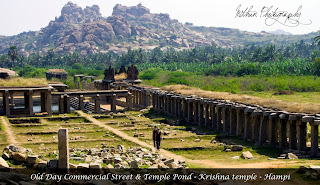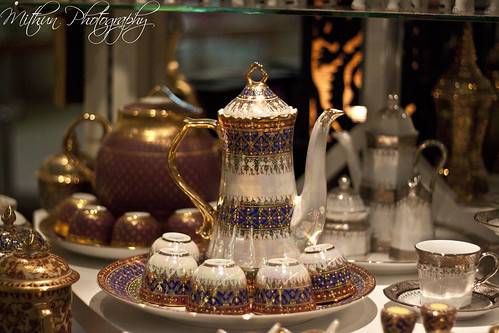The magnificent Virupaksha Temple lies at the western end of the famous Hampi Bazaar. On its eastern entrance the temple has a 120 feet high towers. Virupaksha temple houses the shrines of Shiva, Pampa and Bhuvaneswari. Some portions of this temple are older than the Vijayanagar Kingdom, dates back to the 11th or 12th centuries. Close to this temple is the 6.7 m tall monolith statue of Ugra Narasimha. According to a nearby inscription it was hewn from a single boulder in 1528 during the reign of Krishnadeva Raya.
– Kadle Ganesh –
 |
| Kadle Ganesh Temple Complex |
On the slope of Hemakuta Hill, near the Sasivekalu Ganesha is another monolith called in the same vein, the Kadalekalu (gram seed) Ganesha. The huge seated God, carved in the round out of a massive boulder, is about 4.5 metres high and is housed in a large shrine with a fine open pillared mantapa in front. The tall, slender and graceful pillars are of the ornate cubical Vijayanagara type with solid early corbels. The mantapa is singularly classical in its architectural proportions and has been admired by many architects and critics. The temple also forms one of the important vintage points from which a good and picturesque view could be had of the Hampi monuments.
 This temple complex has been recently excavated through the last decade, and restoration work is still in progress.
This temple complex has been recently excavated through the last decade, and restoration work is still in progress.
This is a ruined temple, south of Hampi and Hemakuta hill. It was built by the emperor Krishnadevaraya after military campaigns in Orissa. The temple is contained in twin enclosures. Parts of the temple and its compound have collapsed, and while some restoration has been carried out, it is generally in poor condition. There is now no image in the inner sanctuary.
– Lakshmi Narasimha –
It is said every stone in Hampi has a story to tell. These boulder-like two similar looking stones (in the picture) are called Sister Stones. According to legend, two jealous sisters visiting Hampi were commenting badly about the city. The city goddess heard this and turned them into stones!
On march 2011 one of the two gigantic boulders of Sisters Stone and considered one of the important land marks at the Hampi heritage city, was found broken. The middle portion of the boulder on the right side has fallen down.
A crack was noticed in the boulder some time ago. Due to extreme weather conditions, with mercury shooting up during summers and dipping during winter, the vibrations caused by heavy vehicular traffic and the sinking of the soil, the crack might have widened and split into two.
– Underground Shiva Temple –
 The temple has a Garbagriha with an antarala and Aradhamantapa and a Mahamantatapa. The mahamantapa has pillared corridors that fuse with the pillared Mukhamantapa, making a larger pillared frontal Mantapa which also encloses a Dwajasthamba. The pillars of this temple are plain.
The temple has a Garbagriha with an antarala and Aradhamantapa and a Mahamantatapa. The mahamantapa has pillared corridors that fuse with the pillared Mukhamantapa, making a larger pillared frontal Mantapa which also encloses a Dwajasthamba. The pillars of this temple are plain.– Nobelmen’s Palace –
Noblemen’s Palace was discovered few years back. It is believed that this palace was for aristocrats and high-ranking officials. It was made of sandalwood. Now only the base remains.
– Lotus Mahal –
A palace for the queen Looking like a lotus flower, the two-story structure has magnificent arc ways set in geometric regularity. Lotus Mahal was an air-cooled (Pipes with running water) summer palace of the queen.
IT was constructed in the later Vijayanagara period, this structure shows Islamic influence in its arched gateways and vaulted ceilings. Its construction entirely in stone is a clear deviation from conventional Vijayanagara palace and house construction that used wooden structures on stone platforms.
– Elephant stables –
– Ramachandra Temple or Hazara Ramaswami Temple –
 The temple stands in a rectangular courtyard, with entrances facing to the east. Reliefs showing daily life and festival scenes occur on the outer walls of the courtyard. Scenes from the Ramayana occur on the inner courtyard walls, and on the temple itself. There is a well-relief of baby Krishna on the walls.
The temple stands in a rectangular courtyard, with entrances facing to the east. Reliefs showing daily life and festival scenes occur on the outer walls of the courtyard. Scenes from the Ramayana occur on the inner courtyard walls, and on the temple itself. There is a well-relief of baby Krishna on the walls.
– The Royal Centre –
 This extensive area consists of a small plateau, which starts about 2 km (1.2 mi) to the southeast of Hampi, and extends southeast, almost to the village of Kamalapuram. It is separated from the Sacred Centre by a small valley, now consisting of agricultural fields, and which carries irrigation canals or streams that join the river opposite Anegondi. A granite platform overlooks the Royal Centre.The Royal Centre contains the ruins of palaces, administrative buildings, and some temples directly associated with royalty. Little remains of the palaces except the foundations, as they were largely timber structures, for comfort. The temples and some of the other stone structures survive however, as do many of the surrounding city walls.
This extensive area consists of a small plateau, which starts about 2 km (1.2 mi) to the southeast of Hampi, and extends southeast, almost to the village of Kamalapuram. It is separated from the Sacred Centre by a small valley, now consisting of agricultural fields, and which carries irrigation canals or streams that join the river opposite Anegondi. A granite platform overlooks the Royal Centre.The Royal Centre contains the ruins of palaces, administrative buildings, and some temples directly associated with royalty. Little remains of the palaces except the foundations, as they were largely timber structures, for comfort. The temples and some of the other stone structures survive however, as do many of the surrounding city walls.– House of Victory –
House of Victory was constructed by Krishnadeva Raya when he returned after his victorious expedition against the king of Orissa. The Vijayanagar kings used to sit on a huge throne in the House of Victory to see the nine-day Dussehra festival.

– Pushkarani or Stepped Tank –
Also called the Stepped Bath, or the Queen’s bath, this is a stepped well designed for bathing. Such sunken wells were created to provide relief from daytime heat. It would have been covered when the city was occupied.

– Mahanavami Dibba –
Mahanavami Dibba is a big platform having beautiful carvings. Actually the Mahanavami Dibba is the foundation of a lion story wooden structure from which the royal family of Hampi used to see pomp, colour and revelry during the Mahanadu festival.
– Hemakuta Hill –
– Sugriva’s cave –
– Vittala Temple Complex-
 This is perhaps the most famous and well-known among the ruins of Hampi. The iconic stone chariot in the vicinity of this temple complex is a symbol of Karnataka Tourism. Off late, floodlights have been installed in the temple complex that provide illumination at dusk, thereby adding to the grandeur of the architecture.
This is perhaps the most famous and well-known among the ruins of Hampi. The iconic stone chariot in the vicinity of this temple complex is a symbol of Karnataka Tourism. Off late, floodlights have been installed in the temple complex that provide illumination at dusk, thereby adding to the grandeur of the architecture.Situated northeast of Hampi, opposite the village of Anegondi, this is one of the principal monuments of the city. It is dedicated to Vittala, an aspect of Vishnu worshipped in the Maratha country. It is believed to date from the 16th century.
 One of the notable features of the Vittala Temple is the musical pillars. Each of the pillars that support the roof of the main temple is supported by a pillar representing a musical instrument, and is constructed as 7 minor pillars arranged around a main pillar. These 7 pillars, when struck, emanate the 7 notes from the representative instrument, varying in sound quality based on whether it represents a wind, string or percussion instrument.
One of the notable features of the Vittala Temple is the musical pillars. Each of the pillars that support the roof of the main temple is supported by a pillar representing a musical instrument, and is constructed as 7 minor pillars arranged around a main pillar. These 7 pillars, when struck, emanate the 7 notes from the representative instrument, varying in sound quality based on whether it represents a wind, string or percussion instrument.– Stone Chariot –
 The Stone Chariot in the front is called the Garuda Mandapa and it is only of its kind in the entire country.(one in Uttara Kosa Mangai near Ramnad and another one in KOnarak). This Stone Chariot is to be admired as to 1)How the wheels have been in stone?
The Stone Chariot in the front is called the Garuda Mandapa and it is only of its kind in the entire country.(one in Uttara Kosa Mangai near Ramnad and another one in KOnarak). This Stone Chariot is to be admired as to 1)How the wheels have been in stone?
2)How they have positioned the wheels.
3)How the Garuda Mandap has been carefully placed on the bottom supporting platform (as can be seen in the pics below). If you start asking questions like this our heads would start rotating like a wheel!Hats off to those sthapathis of 1513!!
– King’s Balance –
This structure, the Tulapurushandana, stands to the southwest of the Vittala temple. consists of two carved granite pillars, spanned by a carved horizontal granite transom. This was used on ceremonial days, when scales were hung from the transom, and the Raya (the emperor) was ceremonially weighed against gold or jewels. The treasure was then distributed, to Brahmins or others in the city.
– Aneghundi and Sri Navabrindava –
2KM north of Hampi lies this old town Aneghundi,and this was thei first Kingdom of the Vijayanagar Kings before they moved over to Hampi.You can see the old fort in Aneghundi still. One calls this place the mythical Kingdom of Kishkinda and there is a Hanuman temple on top of the Hills and its really steep to climb.
– Tungabhadra Dam & Musical Fountain-
About 15 km upstream from Shimoga at Gajanur across the River Tunga a dam is constructed. At Lakkavalli about 15 km upstream of Bhadravati across the Bhadra a dam is constructed. Both are multipurpose dams and irrigate lands in Shimoga, Chikkamagalur, Davanagere and Haveri.
TungaBhadra dam is constructed across river Tungabhadra, a tributary of River Krishna. The dam is built near the town of Hosapete in Karnataka. It is considered as a multipurpose dam or project. Its storage capacity is 135 Tmcft. Owing to siltation the capacity has been reduced by about 30 Tmcft. If there is seasonal and late rains, the dam distributes the estimated quantity of 235 Tmcft. The dam is filled as when the water is let into the canals during the rainy season. The main architect of the dam was Thirumalai Iyengar, an engineer from Madras. As Tungabhadra Dam was constructed by him, so a general purpose hall in this place was named after him. Multipurpose dams are the one’s which help in generation of electricity, irrigation of land, Prevention and control of floods etc. It has become a picnic or tourist spot over the years. The dam is near to world famous heritage site Hampi.
At Sunkesula, about 25 km upstream from Kurnool a barrage was constructed at about 1860s by the British Engineer, hailed as Bhagiratha for Andhras, Sir Arthur Cotton. Originally was intended to be used for navigation also. As the road and rail transportation increased it is now an irrigation project, for Kurnool and Kadapa Districts, carrying water through the renowned K.C.Canal.(Kurnool – Cuddapah canal- Till recently Kadapa was spelled “Cuddapah”). Recently the barrage is replaced by the Kotla Vijayabhaskara Reddy Project- a permanent dam. It impounds about 15,000,000,000 cubic feet (0.42 km3) of water and irrigates about 300,000 acres (1,200 km2) of land in Kurnool and Kadapa districts.










































0 Responses
hi..thanks for sharing..this week end i am planning a trip to br hills resort and also near by place k gudi resort...
Nice blog post with useful information,Hampis is one of the famous tourist places in Karnataka,near tourist places is Daroji Bear Sanctuary, Bellary Fort,
This comment has been removed by the author.
This comment has been removed by the author.
Thanks for sharing this post.
Online Travel Portal
Online Bus Ticket booking
Low Cost Air Tickets Online Booking
Online Hotel Reservations
Holiday Packages India
mobile Bus Ticketing
Online bus Ticket Booking API
flight Booking API
Wow what an amazing post about your travel experience.I loved reading your travelogue.Thank you for sharing the information.Kallada Travels